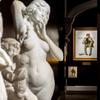Iconography of Power: Napoléon and the Arts
- December 15, 2016 15:34
Brilliant general and legendary conqueror, Napoléon Bonaparte was one of the Western world’s most important leaders, as well as one of its greatest patrons of the arts. Few other leaders in world history have understood the power of the image as deeply as Napoléon, and following his meteoric rise to power, he sought to develop a new iconography that bolstered his image in the eyes of the world. Thus, a new age of decorative and fine arts was born that validated his reign, and from behind this new glittering façade, he attempted to conquer the world. The current exhibition at M.S. Rau Antiques explores the complexities of this era of Empire, which produced art of extraordinary beauty, as well as complex social and political significance.
Beginning with the French Revolution, this comprehensive exhibition spans nearly the entire lifespan of the legendary leader, and beyond to the years following his death. Yet, it also tells the compelling story of the rise and fall of the Empire style, beginning with its roots in the furniture of the Directoire period and through the highly influential Egyptian campaigns. Within the context of the exhibition, the style reaches its apex as Napoléon crowns himself emperor, and is embodied by an extraordinary mahogany and mercury-gilded bronze bedroom suite set once owned by the Egyptian kings.
Inspiration for this 7-piece suite came from the furniture of Malmaison, one of the Parisian palaces of Napoléon and the Empress Joséphine. Friend or foe, it seemed, followed the trends created in France, and the Empire style not only appeared in Egyptian furniture such as this, but also in the Biedermeier style of Germany and Austria and the British Regency style. Informed by simple luxury and masculine elegance, Empire was an appealing blend of neoclassicism and warlike rigidity, and at its apex was the Château de Malmaison.
Josephine purchased the charming, yet rundown, country chateau on the outskirts of Paris in 1799 while Napoléon was still in Egypt. Initially furious with her extravagance, he soon discharged her debts and hired the most fashionable architects of the day, Charles Percier and Pierre Fontaine, to redecorate the home. Through their work, the young pair would famously fashion the Empire style - a new period in decorative arts that conveyed the majestic grandeur of Napoléon’s new imperial regime.
The Empire style was inspired by the iconography of the great ancient empires, particularly Greece and Rome. While the classical world long served as inspiration to architects and designers throughout Europe, Napoléon was able to use symbols from antiquity in a way that would be relevant to his time and place - namely, to promote his Empire. He was ever-conscious of the frailty of his position - before Napoléon took over power, French rulers had governed by divine right, and it was God and God alone who gave the king his legitimacy. Napoléon’s rule, however, was self-legitimating, and much of his power was visually affirmed by those ever-present icons that surrounded him.
Those icons are seen time and time again throughout the exhibition, from the laurel wreath, an historic crowning emblem that resonates victory, power and glory, to the Imperial eagle, a symbol of the god Jupiter and the insignia of the ancient Roman legions. Through his new repertoire of symbols such as these, Napoléon very deliberately styled himself after the great civilizations of the past, creating the illusion of longevity, permanence, and power.
While his reign as emperor lasted just eleven years, his far-reaching influence is still felt across the centuries. He was, and remains, one of the greatest military and political minds of the modern era, nearly forging a vast European Empire and leaving a legacy of greatness. His hopes and aspirations live on in his highly personal imperial iconography and persona of power that still resonate today.
Napoléon: General. Emperor. Legend. runs through January 7 at M.S. Rau Antiques’ French Quarter Gallery. Click here for more information about the works in this visually appealing, historic exhibition that is truly a once-in-a-lifetime experience.
About M.S. Rau Antiques:
M.S. Rau Antiques has spent over 100 years earning the trust of discerning collectors world-wide. Located in the heart of New Orleans’ historic French Quarter, our peerless gallery houses one of the world’s most extensive and stunning collections of important fine art by artists such as Monet and Rockwell, rare 18th- and 19th-century antiques and breathtaking jewelry, including rare colored diamonds.






100x100_c.jpg)














